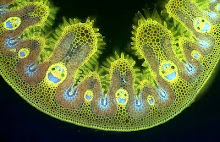I posted some pictures a couple of weeks ago of Sparmannia africana, which has remarkable stamens that spread outwards after they are touched. Here's another genus with touch-sensitive stamens - Mahonia - but in this case the stamens move in the opposite direction when they've been stimulated. The plant portrayed here is the hybrid between M.japonica and M. lomariifolia known as M. x media 'Charity', which has long racemes of lily-of-the-valley scented flowers that open in autumn and bloom well into winter, producing purple-blue berries that blackbirds love in early spring. In my garden I've watched over-wintering blackcaps pecking the flowers in this species and there a suspicion that they may be after the nectar, as the flowers don't attract any insects at this time of the year.
When the flowers first open the six stamens are spread wide, pressed against the petals, but if you touch the base of the stamen filament there's a slight delay and then they quickly move inwards, eventually coming to rest against the stigma.
Here's a flower where I poked the base of four of the six stamens with a pine needle. Three have closed on the stigma and the fourth is well on the way. The speed of movement depends on the ambient temperature - it was a cold day when I triggered these - but under warm conditions it takes about one second. Why do they do this? Hard to be sure, but I guess that it's likely that the foot of a visiting insect triggers the stamen movement, which forces pollen onto the insect's leg.
Mahonia and the closely related Berberis species have touch-sensitive stamens. Some botanists argue that species in these two genera should be amalgamated under the single genus Berberis, because they are so similar and some Mahonia and Berberis can form inter-generic hybrids (x Mahoberberis).
There's one other startling feature of these two genera that you can't see unless you prune off large branches. Their wood is bright yellow, due to the presence of a natural dye called berberine. The brilliance of the yellow wood is startling - even more so if you view it under ultra-violet light, because the berberine then fluoresces even brighter yellow.
















